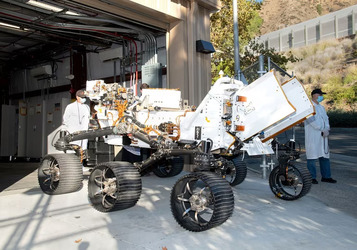The week's pick
Random Articles
Reseach Article
A Conceptual Semi-Humanoid Wireless Robotic Lecturer for Distance Learning (DL)
| Communications on Applied Electronics |
| Foundation of Computer Science (FCS), NY, USA |
| Volume 5 - Number 5 |
| Year of Publication: 2016 |
| Authors: Victor O. Matthews, Felix O. Olowononi, Emmanuel Adetiba, Oluyinka Oni |
 10.5120/cae2016652296
10.5120/cae2016652296
|
Victor O. Matthews, Felix O. Olowononi, Emmanuel Adetiba, Oluyinka Oni . A Conceptual Semi-Humanoid Wireless Robotic Lecturer for Distance Learning (DL). Communications on Applied Electronics. 5, 5 ( Jul 2016), 9-15. DOI=10.5120/cae2016652296
Abstract
Information and Communications Technology is causing a worldwide revolution in virtually all fields of human endeavor. The education sector is not left out as the delivery of course content is no longer limited to the traditional teacher-student classroom interaction but also via electronic media. This paper presents a novel approach to e-Learning by leveraging on advancements in Machine-to-Machine communications (M2M), Internet-of-Things (IoT) and robotics technologies to design and construct a semi-humanoid class teaching robot that aids teachers, lecturers and other educational personnel in communicating effectively with the students irrespective of their location and the distance using a plastic mannequin. The implementation of the system is achieved through hardware (mannequin) and software designs. The authors successfully developed a plastic mannequin with embedded electronics systems to work as a telepresence lecturer, allowing the elimination of time and distance between a professional remote educator and the students. The device was tested and compared with existing remote teaching technologies such as teleconferencing, telepresence with tablet screens and found to be more reliable, cheaper, and easy to use than the existing ones. The paper therefore concludes that the semi-humanoid robotic lecturer is a disruptive innovation in the world of Distance Education Learning (DEL).
References
- 2013/2014 Education For All (EFA) Global Monitoring Report, “Teaching and Learning: Achieving Quality for all”© United Nations Educational, Scientific and Cultural Organization (UNESCO) 2014
- TelePresence in Education, A Cisco White Paper © 2007, Cisco Systems Incorporated (Available Online: www.cisco.com/web/strategy/education/telepresence_for_schools.html)
- Teachers and Educational Quality: Monitoring Global Needs for 2015; © UNESCO Institute for Statistics (UIS) 2006 (Available Online: www.uis.unesco.org/publications/teachers2006
- Internet of Learning-Things,” Edutech Associates, August 2013, http://bit.ly/1g3wPGP
- Facing the World: Telepresence in Education, A publication of California State University, Monterey Bay; Sponsored by Cisco Systems
- “NMC Horizon Report, 2013: HiEd Edition,” The New Media Consortium, http://www.nmc.org/publications/2013-horizon-report-higher-ed
- http://supermechanical.com/twine/
- “Embracing the Internet of Everything To Capture Your Share of $14.4 Trillion,” Cisco, 2013.
- Allison C.R, Allison C.N, “The goals of E-Learning and Distance Learning towards the educational development of Nigerian Public Service”, International Journal of Research
- r Trends and Technology (IJCTT), Vol.12, No 2, June 2014 ISSN: 2231 -5381 (Available Online: http://www.ijettjournal.org)
- P.C. et al., “What drives a successful e-Learning? An empirical investigation of the critical factors influencing learner satisfaction”, Computers & Education (2007), doi:10.1016/j.compedu.2006.11.007 (Available online at www.sciencedirect.com)
- Hassan Selim, “E-Learning Critical Success Factors: An Exploratory Investigation of Students Perceptions”, Managing Modern Organizations Through Information Technology, Proceedings of the 2005 Information Resources Management Association International Conference, Copyright © 2005, Idea Group Inc
- Zaman M.T, Ahmed M.S, “Design and Construction of a Multipurpose Robot”, International Journal of Automation, Control and Intelligent Systems, published by American Institute of Science, Vol.1, No. 2, 2015, pp34-46 (Available Online: http://www.aisience.org/journal/ijacis)
- Wesley L. Stone, The History of Robotics , In book Robotics and Automation Handbook, Thomas R. Kurfess; Publisher: CRC Press LLC, USA, 2005; pp. 13-20.
- Aboshosha, A. Zell, “Adaptation of Rescue Robot Behavior in Unknown Terrains Based on Stochastic and Fuzzy Logic Approaches”, In: Proceeding of IEEE/RSJ International Conference on Intelligent Robots and Systems-2003(IROS2003), Vol. 3, 27-31 Oct, 2003, pp.2859-2864.
- M Veloso, P Stone, and M Bowling, “Anticipation as a Key for Collaboration in a Team of Agents: A Case Study in Robotic Soccer”, In: Proceedings of SPIE Sensor Fusion and Decentralized Control in Robotic Systems II, SPIE, Bellingham, WA, September 1999, pp. 134–143.
- Q Liu, Y Lu and C Xie, “Optimal Genetic Fuzzy Obstacle Avoidance Controller of Autonomous Mobile Robot Based On Ultrasonic Sensors”, In: Proceeding of IEEE International Conference on Robotics and Biometrics, Kunming, China, 17-20 Dec, 2006, pp. 125-129.
Index Terms
Keywords

